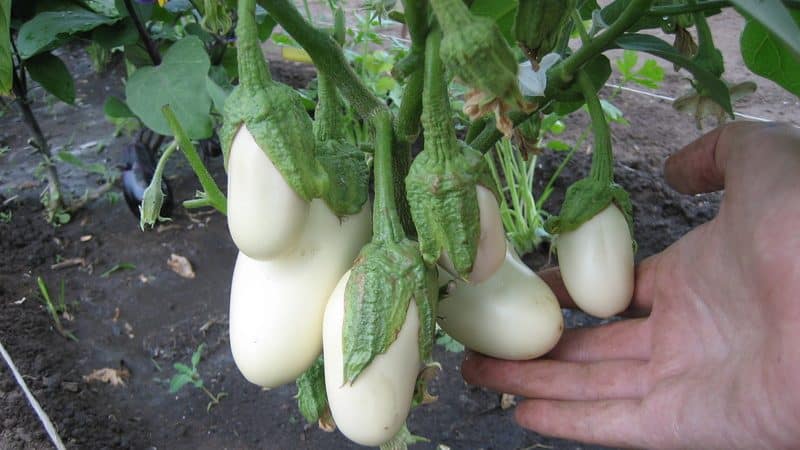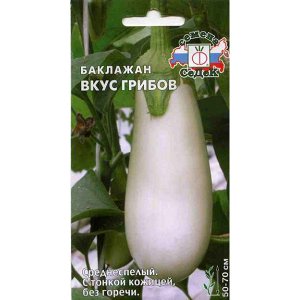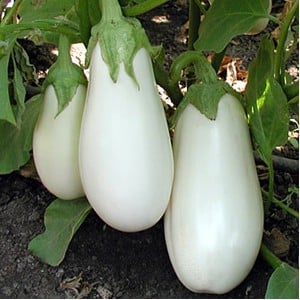What difficulties should a summer resident prepare for when growing eggplant “Taste of Mushrooms”?
Many housewives have heard that if you cook eggplants in a special way, they will acquire a mushroom taste. Some even tried various recipes for this outlandish dish. Unfortunately, expectations and reality do not always coincide. Experimental cooks often complain that despite all their efforts, they end up with the most ordinary eggplants. But perhaps the reason for such failures lies not in a bad recipe, but in the wrong variety of vegetables.
Eggplants The taste of mushrooms really has the aroma of champignons. They definitely won’t disappoint mushroom lovers. What advantages does this amazing variety have, and is it difficult to grow it on your own plot - read on.
Description of the variety
White eggplant The taste of mushrooms from “Sedek” was bred by domestic breeders in early 2000, but only in 2009 the variety was included in the Russian state register.
The variety is distinguished by unusual fruits. They're not dark purple blue or burgundy, like other eggplants, but white, which gives them a truly exotic look.
 The tender pulp of this variety lacks the bitterness characteristic of eggplants. The aroma is rich, mushroom. Some gourmets believe that the taste of mushrooms is more reminiscent of chicken than champignons.
The tender pulp of this variety lacks the bitterness characteristic of eggplants. The aroma is rich, mushroom. Some gourmets believe that the taste of mushrooms is more reminiscent of chicken than champignons.
Eggplant is also distinguished by its cold resistance. This is one of the few varieties that can grow in the central regions without a greenhouse.
The variety is immune to diseases of nightshade crops. This makes it much easier to care for.
Advantages and disadvantages
Many vegetable growers, having tried the Taste of Mushrooms, leave positive reviews about it. This is due to the extensive list of its advantages:
- mushroom taste;
- unusual white color of the fruit;
- good yield;
- immunity to nightshade diseases;
- ease of care;
- the ability to use seeds collected from fruits for sowing.
The disadvantage of the variety is the fact that the white fruits lack valuable anthocyanin. This is a powerful antioxidant, the effects of which have a beneficial effect on the body.
We also note the small size of the fruits. Some gardeners consider this a disadvantage, although many consider it an advantage - it depends on the purpose of cultivation.
Difficulties in growing
 Eggplants The taste of mushrooms is unpretentious. Growing them is no more difficult than any other variety of this crop. Moreover, the white variety is cold-resistant and immune to nightshade diseases.
Eggplants The taste of mushrooms is unpretentious. Growing them is no more difficult than any other variety of this crop. Moreover, the white variety is cold-resistant and immune to nightshade diseases.
Despite the hardiness of the crop, gardeners should become familiar with the difficulties in growing that sometimes arise:
- The variety is demanding on fertilizing. They are applied at least four times per season. Otherwise, the yield will be low and the fruits will be small.
- Despite its immunity to nightshade diseases, according to gardeners, this variety is sometimes affected by infections. To prevent this from happening, it is important to follow the rules of care and regularly spray the bushes with antifungal drugs.
- In dry weather, the bushes begin to drop their fruits. To avoid this, plants are provided with regular watering.
General characteristics of eggplants Taste of mushrooms
Mushroom flavor is a great option for both experienced and novice vegetable growers. It will surprise you not only with its unusual aroma, but also with a number of other parameters.
Characteristics and description of the variety:
| Options | Indicators |
| Bush type | Shrubs with limited growth. They reach a height of 60-70 cm and are highly branched. The bushes are powerful and durable, covered with light pubescence, dark green in color (there are no purple tones in the color). The leaves are medium in size, slightly wavy along the edges and have a dark green tint. Plants are medium leafy. |
| Fruit | Medium size. The weight of each berry varies between 100-180 g. The length of the fruit does not exceed 20 cm. The shape is cylindrical or slightly pear-shaped. Shell color is white. The pulp has a creamy tint. The seeds are small and soft. The pulp is tender, without bitterness, with a mushroom aroma. |
| Productivity | High. From 1 sq. m get up to 6.5 kg of fruit. |
| Ripening time | Early. The fruits appear 95-105 days after sowing the seeds. |
| Transportability | High. The fruits are suitable for transportation over long distances and are capable of stored in a cool place for more than a month. |
| Growing conditions | The variety is resistant to temperature changes. Suitable for cultivation in open ground and in greenhouses in the southern and central regions. |
| Disease resistance | Has immunity to diseases of nightshade crops. |
How to grow Taste of mushrooms in your garden
The taste of mushrooms is a temperature-resistant eggplant variety. It is grown in open and protected ground. In the second case, the yield will be higher.
Eggplants in our country are cultivated only by seedlings. Otherwise, the plants simply will not have time to harvest for frost.
For eggplants, choose beds where other nightshade crops have not grown in the past two years. This variety feels best after greens, melons, onions and cucumbers.
Note! Eggplant is a light-loving crop.In shaded areas, they do not form an ovary or produce small, deformed and tasteless fruits.
Sowing seeds and growing seedlings
Seedlings begin to be grown two months before the expected selection to a permanent place. The time for sowing seeds depends on the region: in southern cities - at the end of February or early March, in cities with a temperate climate - in the second half of March.
Loose and nutritious soils are suitable for growing seedlings. Stores sell mixtures for nightshade crops and universal soil.
 They prepare the soil on their own. To do this, mix: 2 parts peat, 1 part humus and 0.5 part washed sand. Take 1 tbsp per bucket of the resulting composition. ash and 2 tbsp. l. superphosphate.
They prepare the soil on their own. To do this, mix: 2 parts peat, 1 part humus and 0.5 part washed sand. Take 1 tbsp per bucket of the resulting composition. ash and 2 tbsp. l. superphosphate.
Eggplants do not like picking. Therefore, the seeds are sown immediately in individual containers with a volume of 300-500 ml. Both homemade containers made from scrap materials with drainage holes at the bottom (disposable cups, juice boxes, cut-off bottles) and special pots (plastic or peat) are suitable. Some gardeners use special cassettes or peat tablets.
Also, to grow seedlings you will need drainage. Shell stone, broken ceramics, crushed brick or expanded clay, and small crushed stone are suitable.
The soil, containers and drainage must be disinfected. Use a dark pink solution of potassium permanganate or hot copper sulfate (1 tsp per 3 liters of water).
Before planting, the seeds are prepared. This process includes the following steps:
- the package with seeds is placed on the battery for two weeks;
- planting material is soaked for 30 minutes in a light pink solution of potassium permanganate or for 15 minutes in hydrogen peroxide;
- the seeds are washed;
- According to the instructions, the planting material is treated with a growth stimulator (Epin, Kornevin, etc.).
After processing, the seeds are ready for sowing. Three seeds are planted in each pot filled with drainage and soil, to a depth of 1 cm. They are sprinkled with earth and moistened with warm water from a spray bottle.
The containers are covered with film or glass and placed in a place with a temperature of 25-27 °C. All this time, the soil is moistened with a spray bottle.
During the process of growing seedlings, they are provided with regular and proper care:
- When the first shoots appear, the film or glass is removed. The plants are moved to a well-lit, cool place (15 °C) for a week. Then the seedlings are grown at room temperature.
- The soil is moistened as it dries. Use warm, settled water. It is poured directly under the roots of plants.
- Eggplants only need 10-12 hours of daylight. Therefore, the use of fluorescent lamps will only be needed if the seeds were sown in February.
- Two weeks after the first shoots appear, weaker plants are pinched. There should only be one eggplant left in the pot.
- 14 days after seed germination and then every two weeks, apply any complex mineral fertilizer. The last application of fertilizer is done five days before transplanting the seedlings to a permanent place.
- Two weeks before planting seedlings in open ground, they begin to harden them. To do this, it is taken outside during the warm part of the day, gradually increasing the time spent in the fresh air.
Picking to a permanent place
The seedlings are moved to a permanent location when the soil at a depth of 15 cm warms up to 15°C. In the southern regions this happens at the end of April, and in the central regions - in the second half of May.
In the fall, the beds are prepared. They are dug up and cleared of weeds. For 1 sq. m add 6 kg of humus or rotted manure and 45 g of superphosphate.
In spring, the beds are leveled and cleared of weeds. For 1 sq. m add 20 g of urea. Then the soil is watered with a hot solution of copper sulfate.
Advice! Experienced vegetable growers prefer to grow eggplants in beds 30 cm high and 100 cm wide.
On such beds there are two rows of holes. Use a 60x40 cm pattern.
Pour 1 liter of water into each cavity and add 1 tbsp. l. ash. Then eggplants are planted there, deepening the root collar by 2 cm. The holes are sprinkled with soil, which is compacted in a circle. Then the eggplants are watered again, spending 1 liter of water per bush.
Plant care
The taste of mushrooms does not require pinching. Experienced gardeners recommend removing vegetation in the lower part of the bush, as well as yellowed and withered greenery. This procedure is carried out once every two weeks.
Advice! To get larger fruits, only eight ovaries are left on one plant.
 The plants, although low-growing, sometimes bend under the weight of the fruit. They should be tied to the support with synthetic thread.
The plants, although low-growing, sometimes bend under the weight of the fruit. They should be tied to the support with synthetic thread.
Water the eggplants every 3-4 days. Water is poured only at the root. The procedure is carried out early in the morning or at sunset, when the sun is inactive.
After each watering, the soil is loosened. This destroys the earthen crust that impedes air exchange.
Advice! To avoid frequent loosening and weeding, as well as to protect plant roots from cold weather and pests, it is recommended to mulch the beds. To do this, they are covered with a layer of hay, straw, peat or sunflower seed husks.
Fertilize every two weeks. Use the following scheme:
- Organic fertilizers are applied before flowering.For example, a solution of chicken manure with water in a ratio of 1:10. Add 2 tbsp to a bucket of this mixture. l. superphosphate.
- During flowering and fruit growth, potassium fertilizers are applied. It is prepared from 1 tsp. potassium monosulfate diluted in a bucket of water.
- During flowering, the bushes are also sprayed with boric acid. This increases the number of fruits.
Prevention of diseases and pests
The taste of the mushrooms is resistant to diseases of nightshade crops. According to reviews, some infections can still affect it.
To prevent this from happening, follow the rules of prevention:
- Compliance with disinfection rules. Disinfecting compounds are used to treat the soil, seedling containers, greenhouse walls, garden tools and the seed itself.
- Preventive dusting of plant leaves and beds with wood ash. This method will protect plants from fungal infections and pests.
- Preventive treatment with antifungal drugs. Most gardeners use Fitosporin for these purposes.
Pest prevention is equally important. They spread fungal and viral infections and destroy eggplant bushes and fruits. Here are the most common methods used to prevent crop damage by harmful insects:

- Soap solution. A piece of grated laundry soap is dissolved in a bucket of water. Plants are sprayed with this product. It helps fight aphids, spider mites and whiteflies.
- Pepper tincture. Three hot peppers are passed through a meat grinder and dissolved in 5 liters of water. Add 1 tbsp to the mixture. l. tobacco ash and 2 tbsp. l. detergent. This drug is used both for the prevention of pests and for their control.
- Herbal decoction. Bitter herbs are used (dandelion, wormwood, yarrow, celandine). They fill a quarter of the bucket, the rest of the volume is filled with boiling water. The product is infused for several hours and used to spray plants.
- Chemicals. Such drugs as "Decis" and "Barrier" are suitable.
Reviews from gardeners
Reviews from gardeners who have tried eggplant The taste of mushrooms are mostly positive. Many are surprised that the fruits of this variety actually have a pronounced mushroom aroma.
Tamara, Krasnodar: «I’ve been growing Taste of mushrooms for about 5 years now. The first time I planted it, I didn’t believe that the aroma of champignons would really be present. Imagine my surprise when the guests decided that my winter salad, which I prepared from these eggplants, contained mushrooms. The variety is very easy to care for.”
Victor, Tver: “This year I tried the Taste of Mushrooms. I was attracted by the photo of white eggplants and the promise of a mushroom smell. The fruits do have an unusual aroma. The variety also pleased me with its productivity. I didn’t step it up and didn’t remove any extra ovaries. I fed with superphosphate and potash fertilizers, alternating with silage and chicken manure.”
Read also:
How to freeze fresh eggplants for the winter at home, and what to cook from them.
A productive and early ripening variety of eggplant "Bourgeois".
How to properly dry eggplants for the winter at home: 3 best ways.
Conclusion
The taste of mushrooms is one of the most unusual eggplant varieties. It produces white fruits that are not bitter and do not require soaking before cooking. Gardeners who have tried to grow it say that its taste actually has mushroom notes.
Problems rarely arise when growing this variety.It is resistant to temperature changes and nightshade diseases.